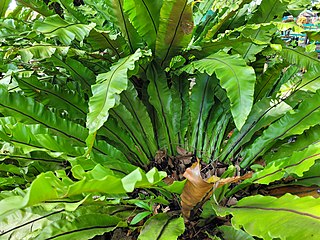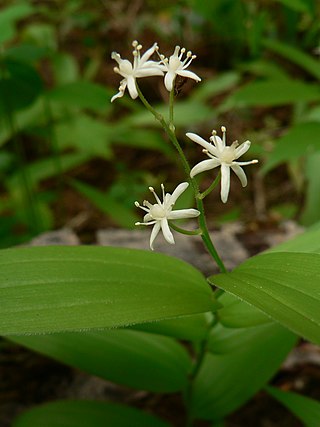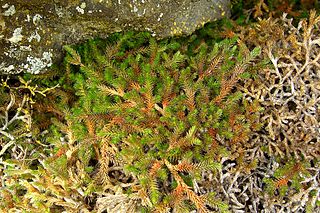
Selaginella is the sole genus in the family Selaginellaceae, the spikemosses or lesser clubmosses, a kind of vascular plant.

Psilotum is a genus of fern-like vascular plants. It is one of two genera in the family Psilotaceae commonly known as whisk ferns, the other being Tmesipteris. Plants in these two genera were once thought to be descended from the earliest surviving vascular plants, but more recent phylogenies place them as basal ferns, as a sister group to Ophioglossales. They lack true roots and leaves are very reduced, the stems being the organs containing photosynthetic and conducting tissue. There are only two species in Psilotum and a hybrid between the two. They differ from those in Tmesipteris in having stems with many branches and a synangium with three lobes rather than two.

Lycopodium is a genus of clubmosses, also known as ground pines or creeping cedars, in the family Lycopodiaceae. Two very different circumscriptions of the genus are in use. In the Pteridophyte Phylogeny Group classification of 2016, Lycopodium is one of nine genera in the subfamily Lycopodioideae, and has from nine to 15 species. In other classifications, the genus is equivalent to the whole of the subfamily, since it includes all of the other genera. More than 40 species are accepted.

Asplenium nidus is an epiphytic species of fern in the family Aspleniaceae, native to tropical southeastern Asia, eastern Australia, Hawaii, Polynesia, Christmas Island, India, and eastern Africa. It is known by the common names bird's-nest fern or simply nest fern.

Pandanus tectorius is a species of Pandanus (screwpine) that is native to Malesia, Papuasia, eastern Australia, and the Pacific Islands. It grows in the coastal lowlands typically near the edge of the ocean. Common names in English include thatch screwpine, Tahitian screwpine, hala tree and pandanus. The fruit is edible and sometimes known as hala fruit.

Selaginella lepidophylla, also known as a resurrection plant, is a species of desert plant in the spikemoss family (Selaginellaceae). It is native to the Chihuahuan Desert of North America and Mexico. S. lepidophylla is renowned for its ability to survive almost complete desiccation. Resurrection plants are vascular rooted plants capable of surviving extreme desiccation, then resuming normal metabolic activity upon rehydration. The plant's hydro-responsive movements are governed by stem moisture content, tissue properties and a graded distribution of lignified cells affecting concentric stem stiffness and spiraling. During dry weather in its native habitat, its stems curl into a tight ball, uncurling only when exposed to moisture.

Psilotum nudum, the whisk fern, is a fernlike plant. Like the other species in the order Psilotales, it lacks roots.

Turritis glabra, commonly known as tower rockcress or tower mustard, is a tall, slim, grey-green plant with small creamy flowers at the top of the stem. It usually grows on poor chalky or sandy soils, in open situations. It is native to Europe, Asia, and North Africa, and it is widespread in North America where it is also probably native. It can be found in many other parts of the world as an introduced species.

Selaginella apoda, commonly known as meadow spikemoss, is a perennial lycophyte native to much of the eastern United States and parts of northeastern Mexico. The life cycle is the shortest of the genus Selaginella, as well as one of the shortest among the lycophytes. Selaginella apoda is found primarily in damp soils in habitats such as swamps, wet fields, open woods and along stream banks. Selaginella apoda presents the potential for case studies involving the plant's adaptability to environmental toxins. A lowland plant, it has only been recorded at elevations below 100 meters. It is closely related to Selaginella eclipes and S. ludoviciana, with both of which it has been reported to form hybrids. This group is characterized by relatively flat strobili and large megasporophylls which occur in the same plane as the lateral leaves.

Maianthemum stellatum is a species of flowering plant, native across North America. It has been found in northern Mexico, every Canadian province and territory except Nunavut, and every US state except Hawaii and the states of the Southeast. It has little white buds in the spring, followed by delicate starry flowers, then green-and-black striped berries, and finally deep red berries in the fall.

Selaginella selaginoides is a non-flowering plant of the spikemoss genus Selaginella with a wide distribution around the Northern Hemisphere. It resembles a moss in appearance but is a vascular plant belonging to the division Lycopodiophyta. It has a number of common names including lesser clubmoss, club spikemoss, northern spikemoss, low spikemoss and prickly mountain-moss. This plant has one close relative, Selaginella deflexa, native to Hawaii. These two plants form a small clade that is sister to all other Selaginella species.

Selaginella kraussiana is a species of vascular plant in the family Selaginellaceae. It is referred to by the common names Krauss' spikemoss, Krauss's clubmoss, or African clubmoss, and is found naturally in parts of Sub-Saharan Africa and in Macaronesia. It is sometimes given the misnomer of “peacock fern”, due to its lacy leaf structure, despite having no relation to actual ferns; rather, it belongs to the very ancient lineage of plants known as the clubmosses.

Selaginella cinerascens is a species of spikemoss known by the common names mesa spikemoss, gray spikemoss, and ashy spikemoss. It is native to Baja California as well as some locations just north of the border in San Diego County, California. It grows in dry habitat, often on clay soil, both in open areas and in the shade of larger plants. This lycophyte forms mats of spreading, forking stems up to 18 centimeters long. The plant is often gray or brown in color, forming a dull-colored carpet on the substrate. The linear or lance-shaped leaves are 1 to 3 millimeters long and lack bristles at the tips. The leaves are green when new or moist. They are flattened to the stem or stick out just a little. The strobili borne at the leaf bases are yellow in color and no more than 4 to 5 millimeters long.

Selaginella oregana is a species of spikemoss known by the common name Oregon spikemoss. It is native to the Pacific Coast of western North America, where it can be found from British Columbia to northern California. It grows in mossy, shady coastal forests. It is often epiphytic, growing attached to tree branches, its stems hanging in sheets of green, mosslike streamers. Trees commonly occupied by the spikemoss include bigleaf maple, black cottonwood, and red alder. It also grows on the ground and on rocks in carpetlike mats. This lycophyte has creeping or hanging stems up to about 60 centimeters long, usually with forking branches. They curl as they dry. The stems are radially symmetric, with spirals of lance-shaped leaves each measuring 2 or 3 millimeters in length and tipped with a tiny, rigid bristle. The strobili containing the reproductive structures are up to 6 centimeters long and often occur in pairs.

Selaginella wallacei is a species of spikemoss known by the common name Wallace's spikemoss. It is native to western North America from British Columbia to California to Montana, where it can be found in many types of habitat, including open and shaded areas, and wet to dry environments, often growing on and over rocks. This lycophyte is variable in appearance, its form depending on the habitat it grows in. It can be spreading with many narrow branches, or a small, dense mat. The forking stems grow up to about 25 centimeters long, but may remain much shorter in dry conditions. They are lined with linear, lance-shaped, or oblong leaves up to 4 millimeters long including the bristles at the tips. The strobili containing the reproductive structures may be quite long, reaching up to 9 centimeters.

Echinocereus viridiflorus is a species of cactus known by the common names nylon hedgehog cactus, green pitaya, and small-flowered hedgehog cactus. It is native to the central and south-central United States and northern Mexico, where it can be found in varied habitat types, including desert scrub, woodlands, dry grasslands, and short-grass prairie.

Dicranopteris linearis is a common species of fern known by many common names, including Old World forked fern, uluhe (Hawaiian), and dilim (Filipino). It is one of the most widely distributed ferns of the wet Old World tropics and adjacent regions, including Polynesia and the Pacific. In parts of the New World tropics its niche is filled by its relative, Dicranopteris pectinatus.

Nephrolepis cordifolia is a fern native to the global tropics, including northeastern Australia and Asia. It has many common names including fishbone fern, tuberous sword fern, tuber ladder fern, erect sword fern, narrow sword fern and ladder fern, and herringbone fern. It is similar to the related fern Nephrolepis exaltata.
Selaginella stellata, also recognized by its common name, starry spikemoss or starry spike-moss, is a species of spikemoss of the family Selaginellaceae. It is a type of lycopod that grows naturally in Mexico and Central American countries like Guatemala and Belize and can also be found in the state of Hawaii.

Selaginella ciliaris is a plant in the family Selaginellaceae which is native to areas from India and Nepal eastwards to China and Taiwan, and south to northern Australia.


















